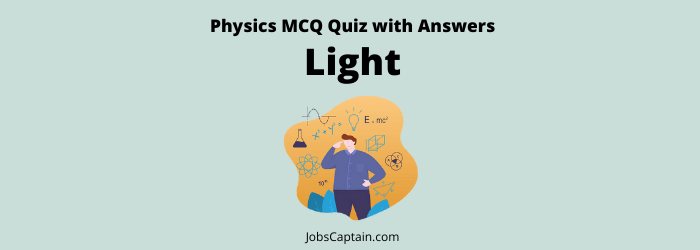
Question 1. The concept of expanding universe is based on ______.
(A) Raman effect
(B) Zeeman effect
(C) Stark effect
(D) Doppler effect
Question 2. Suppose a rocketship is proceeding from the Earth at a speed of 2/10th the velocity of light. A light in the rocketship appears blue to the passengers on the ship. What colour would it appear to an observer on the Earth?
(A) Yellow-Orange
(B) Yellow
(C) Orange
(D) Blue
Question 3. In driving a car which type of mirror would you like to use for observing traffic at your back?
(A) Plain mirror
(B) Convex mirror
(C) Spherical mirror
(D) Concave mirror
Question 4. For shaving, one uses?
(A) Concave mirror
(B) Convex mirror
(C) Plain mirror
(D) None of the above
Question 5. In order to avoid Sunlight, which of the following colour combination for an umbrella is most appropriate?
(A) Only black
(B) Top white and bottom black
(C) Only white
(D) Top black and bottom white
Question 6. The image formed by astronomical telescope is ________.
(A) Real and magnified
(B) Real and diminished
(C) Virtual and magnified
(D) Virtual and diminished
Question 7. The number of images of an object placed between two parallel mirrors is______.
(A) Infinite
(B) Six
(C) One
(D) Two
Question 8. When a mirror is rotated by an angle q, the reflected ray will rotate by______.
(A) 2q
(B) q
(C) q/2
(D) 0
Question 9. Light is made of seven colours. What is the method of separating the colours?
(A) The colours cannot be separated
(B) The colours can be separated by plants
(C) The colours can be separated by a filter
(D) The colours can be separated by a prism
Question 10. The correct order of colours in a rainbow is_______.
(A) Blue, green, yellow
(B) Blue, yellow, green
(C) Violet, green, blue
(D) Blue, green, violet
Question 11. Which of the following lens is used to minimize Myopia?
(A) Convex lens
(B) Cylindrical lens
(C) Concave lens
(D) None of the above
Question 12. When a person enters into a dark room from the strong light area, he is not able to see clearly for some time. Later he gradually begins to see things. This is because_____.
(A) Eyes become familiar with darkness in course of time
(B) Bleaching and reformation of Rhodopsins
(C) Changes in the diameter and focal length of lens
(D) Changes in the size of pupil
Question 13. Reading glasses are made from which type of lenses?
(A) Concave
(B) Plain
(C) Convex
(D)None of these
Question 14. The focusing in the eye is done by______.
(A) Change in the refractive index of the eye fluid
(B) To and fro movement of the retina
(C) To and fro movement of the lens
(D) Change in the convexity of the lens
Question 15. Which one of the following statement is not correct?
(A) Convex mirror with a small aperture is used by doctors to examine, ear, nose or throat of a patient
(B) In summer, white or light coloured clothes are preferred to dark coloured clothes generally
(C) Concave mirrors are used in searchlights
(D) Mirage is an optical illusion arising due to total internal reflection of light
Question 16. The mirror, which is used in searchlights, is______.
(A)Concave mirror
(B) Simple mirror
(C) Convex mirror
(D) None of the above
Question 17. The least distance (in cm) of distinct vision in_____.
(A) 100
(B) 75
(C) 5
(D) 25
Question 18. For normal eyes what is the minimum distance for clear vision?
(A) 25 cm
(B) 20 cm
(C) 15 cm
(D) 10 cm
Question 19. When beams of red, blue and green lights fall on the same spot, the colour of the light becomes______.
(A) White
(B) Yellow
(C) Red
(D) Violet
Question 20. The change of focal length of an eye lense is caused by action of the_______.
(A) Iris
(B) Ciliary muscles
(C) Retina
(D) Pupil
Question 21. Which one of the following statement is not true for a person suffering from hypermetropia?
(A) A concave lens is used to correct this defect
(B) The image of the close objects is focused behind the retina
(C) The focal length of the lens is large
(D) The person can see far objects distinctly
Question 22. To remove the defect of long sightedness one uses_____.
(A) Concave mirror
(B) Convex lens
(C) Convex mirror
(D) Concave lens
Question 23. The minimum height of mirror required to see whole stand up image of a man of height 1.50 metre shall be_________.
(A) 3.00 metre
(B) 1.50 metre
(C) 0.75 metre
(D) 1.00 metre
Question 24. The radius of curvatute of the plane mirror is______.
(A)Zero
(B) Infinity
(C) One
(D) Between one and infinity
Question 25. The minimum height of a plane mirror to see the full size image of a person is equal to_______.
(A) Double the height of the person
(B) One-fourth the height of the person
(C) Half the height of the person
(D) The height of the person
Question 26. An air bubble inside water behaves as a ________.
(A) Cylindrical lens
(B) Divergent lens
(C)Convergent lens
(D) Bifocal lens
Question 27. An air bubble in water will act like a_______.
(A) Concave lens
(B) Concave mirror
(C) Convex lens
(D) Convex mirror
Question 28. In which direction the rainbow is seen at 12 noon?
(A)In the West
(B) In the South
(C) In the East
(D) It cannot be seen
Question 29. The terminal colour bands of the rainbow are______.
(A) Violet and Red
(B) Yellow and Green
(C) Green and Red
(D) Blue and Orange
Question 30. Which one of the following colours is seen in the middle of a Rainbow?
(A) Yellow
(B) Red
(C) Green
(D) Blue
